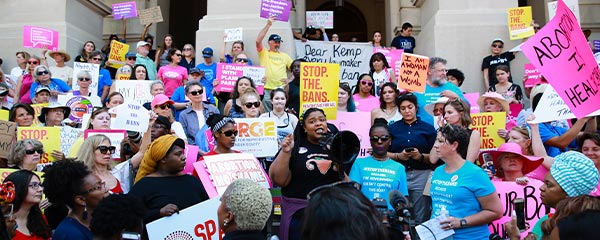PRINCETON, NJ -- Economic policy may be dominating this year's presidential campaign, but the abortion issue appears no less relevant to U.S. registered voters than usual. Seventeen percent say they will vote only for candidates for major office who share their own views on abortion, one of the higher rates of abortion-centric voting seen in presidential election years since 1992.
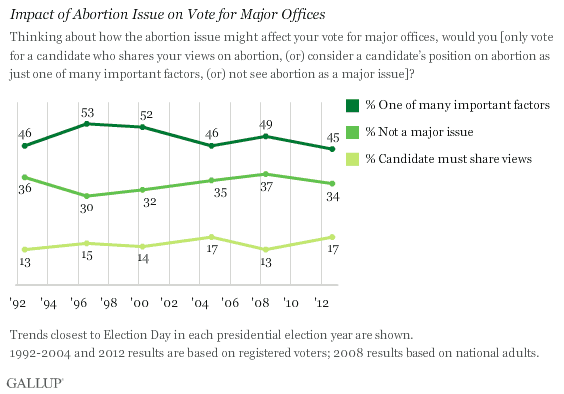
According to the Sept. 24-27 Gallup poll, another 45% of voters say abortion will be one of many important factors they consider in voting, whereas 34% don't see abortion as a major issue.
The impact of the abortion issue on this year's presidential election will depend, more specifically, on the nature of the abortion views held by voters who say they will factor the issue into their vote choice. Gallup finds slightly more pro-life voters than pro-choice voters saying they will vote only for a candidate who shares their views, 21% vs. 15%. That represents 9% and 7%, respectively, of all voters -- a slight pro-life tilt, albeit one that could potentially benefit pro-life Republican candidate Mitt Romney.
Additionally, by 49% to 43%, pro-life voters are a bit more likely than pro-choice voters to say they will consider a candidate's position on abortion as one of many important factors in arriving at their vote choice. That means pro-choice voters are more likely than pro-life voters to say abortion is not a major issue to them.
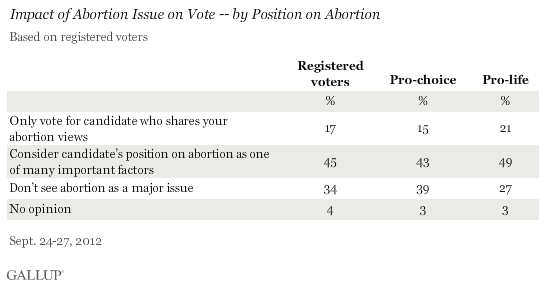
Overall, 48% of registered voters describe themselves as "pro-choice" with respect to abortion and 45% as "pro-life," similar to the nearly even division among all national adults. This essentially matches Gallup's March 2010 update of this measure, the last time it was also asked as an isolated question, rather than after other questions about abortion's legality. The full trend for this version is available in the Survey Methods section at the end of this report.
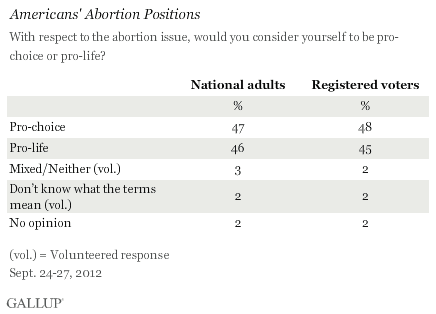
Balance of Pro-Choice- and Pro-Life-Focused Voters Similar to Prior Election Years
The abortion issue has not been getting much play in the 2012 campaign, perhaps due to the candidates' overwhelming focus on jobs, the economy, and other issues high on voters' priority list. For example, although Wednesday night's presidential debate was devoted exclusively to domestic issues, there was no mention of abortion or other values issues. It is also possible that despite past attempts by both parties to politicize their abortion differences, the parity of the pro-choice and pro-life positions among voters has somewhat tempered the issue.
Notably, the current percentages of all registered voters who indicate they are single-issue pro-choice or pro-life voters are similar to what Gallup found in each of the last four presidential election years. In each case, abortion-centric pro-life voters slightly outnumbered abortion-centric pro-choice voters, although this gap was somewhat wider in 2004.
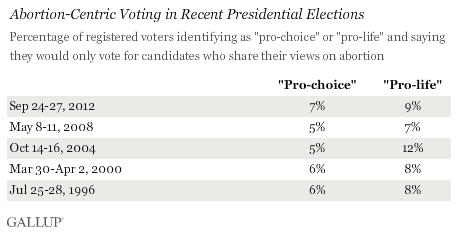
Bottom Line
Approximately one in six registered voters (17%) say they will vote only for candidates for major office who share their views on abortion -- as high a percentage as Gallup has seen in recent election years.
While this is a sizable enough segment of the electorate for the candidates to take note of in principle, the group breaks almost evenly between pro-life (9%) and pro-choice (7%) voters, with another 1% not able to place themselves in either category. This suggests that unless one of the presidential candidates makes a significantly greater effort than the other to encourage turnout among his like-minded abortion voters, the electoral impact of the abortion issue will be minimal. Romney could, however, benefit from the somewhat greater percentage of pro-life than pro-choice voters saying they will at least take abortion into account as one of many important issues.
Regardless, making obvious overtures to abortion issue-voters could hurt Romney and Barack Obama with the broader electorate that may want to see the candidates focusing more single-mindedly on the economy. It could also backfire by activating abortion voters on the other side to turn out for the opponent. However, it is likely that both candidates are using micro-targeting to find and appeal to these voters as part of a comprehensive campaign strategy to maximize support wherever it exists, particularly in swing states.
Track every angle of the presidential race on Gallup.com's Election 2012 page.
Sign up to get Election 2012 news stories from Gallup as soon as they are published.
Survey Methods
Results for this Gallup poll are based on telephone interviews conducted Sept. 24-27, 2012, with a random sample of 1,446 adults, aged 18 and older, living in all 50 U.S. states and the District of Columbia.
For results based on the total sample of national adults, one can say with 95% confidence that the maximum margin of sampling error is ±3 percentage points.
For results based on the total sample of 1,301 registered voters, one can say with 95% confidence that the maximum margin of sampling error is ±3 percentage points.
Interviews are conducted with respondents on landline telephones and cellular phones, with interviews conducted in Spanish for respondents who are primarily Spanish-speaking. Each sample includes a minimum quota of 400 cell phone respondents and 600 landline respondents per 1,000 national adults, with additional minimum quotas among landline respondents by region. Landline telephone numbers are chosen at random among listed telephone numbers. Cell phone numbers are selected using random-digit-dial methods. Landline respondents are chosen at random within each household on the basis of which member had the most recent birthday.
Samples are weighted by gender, age, race, Hispanic ethnicity, education, region, adults in the household, and phone status (cell phone only/landline only/both, cell phone mostly, and having an unlisted landline number). Demographic weighting targets are based on the March 2011 Current Population Survey figures for the aged 18 and older non-institutionalized population living in U.S. telephone households. All reported margins of sampling error include the computed design effects for weighting and sample design.
In addition to sampling error, question wording and practical difficulties in conducting surveys can introduce error or bias into the findings of public opinion polls.
View methodology, full question results, and trend data.
For more details on Gallup's polling methodology, visit www.gallup.com.
